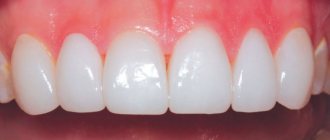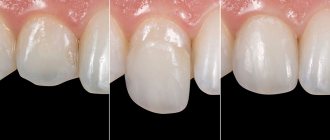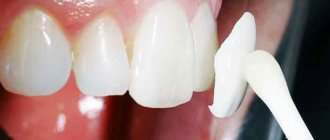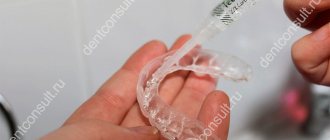Aesthetic (artistic) dental restoration
Artistic or aesthetic dental restoration is the reconstruction of a damaged tooth using composite materials. This treatment is carried out by a dentist-therapist specializing in aesthetic restoration.
To restore one tooth in the smile area (reason: chipped cutting edge, caries), the same composite light-curing materials are used as for filling. The tooth is restored by layer-by-layer application of materials. This technology makes it possible to almost completely reproduce natural enamel in color, transparency and strength.
What are veneers?
This invention can be called nanotechnology of the 21st century, which allows you to create a “Hollywood smile” in a short period of time, without pain. Veneers are plates of various materials with crystals added to them. Ceramic inlays allow you to recreate the aesthetics of a real tooth.
The plates are placed on existing teeth without damaging the enamel. Veneers are installed close to the surface of the tooth, protecting it from external influences and damage, giving shine and whiteness.
Veneers come in different types depending on the manufacturing method:
- Ceramic (porcelain) - finished specimens are prepared in a laboratory using special electronic equipment and require impressions to be taken. Dental restoration with veneers allows you to recreate the aesthetics of the front tooth.
- Composite - their installation is possible without the procedure of taking impressions, no specialized equipment is required. The teeth are veneered with materials from which light-curing fillings are created.
Dental restoration with inlays
If the tooth is severely damaged and most of the crown part is missing, the doctor will suggest restoration using a ceramic inlay. Inlays are created in a dental laboratory using an individual impression. These microprostheses are distinguished by the highest aesthetics and durability.
Advantages of inlays compared to conventional fillings:
- high resistance to external factors (do not change color even from drinking coffee);
- translucency, maximally imitating natural enamel;
- perfect shape, repeating in detail all the features of the destroyed part of the tooth;
- the possibility of shrinkage, which provokes the occurrence of hidden caries, is excluded.
Veneers are placed in the following cases:
- disproportionate size of teeth;
- trauma leading to a chipped tooth plus a violation of its integrity;
- large gaps between teeth;
- dark or yellow enamel;
- violation of the teeth growth line;
- unaesthetic fillings;
- change in tooth color due to fluorosis;
- violation of dental tissue.
Teeth restoration with ceramic (porcelain) veneers has the following advantages: the color is close to natural, dark spots do not appear in the future, they are characterized by strength and durability, and are 100% compatible with gum tissue. Ceramics are easy to clean, plaque does not accumulate there, and is close in characteristics to enamel. From an aesthetic point of view, it has no analogues.
In case of damage, plates can be easily replaced or adjusted by a dentist.
Restoration of the front teeth with veneers can only be done after consulting with a specialist and undergoing diagnostics. They do not require frequent or complex care; a scheduled visit to the doctor once a year is sufficient.
Professional hygiene and whitening
Modern aesthetic dentistry is unthinkable without professional dental hygiene. This procedure gets rid of plaque and tartar, returns the enamel to its natural shade, strengthening it, and is also an excellent prevention of caries.
Whitening is also an important aspect of aesthetic dentistry. Modern in-office whitening techniques (when the procedure takes place in the dentist’s office) make it possible to restore the whiteness of your smile in one session. The doctor may also suggest one of the home whitening systems.
How are the records installed?
During a visit to the clinic, the patient and doctor choose the desired color and shape of the veneers. A layer of enamel up to half a millimeter is removed from the surface, which in the future will replace the ceramic coating. Impressions of the teeth are made and plaster molds are cast onto them. The technician performs artistic work: creates a tooth of the required shape. Ready-made veneers are “glued” to a special compound.
You can get two to eight veneers in one dental visit. This is achieved by restoring teeth with composite veneers.
There are two contraindications for installing veneers: periodontal disease and caries. Having cured the disease, you can begin prosthetics and installation.
Dental veneers: price - what does it depend on?
Almost all dental clinics in Moscow offer veneers - varying in cost, including inexpensive ones. However, not all of these proposals are equally “good”. What to do? How do you know who is trustworthy, where to order veneers, and who to stay away from? How much do high-quality veneers cost for upper and lower teeth?
Our recommendations on how to navigate the clinics:
- Look at the clinic's team of doctors. Particular attention is paid to orthopedic dentists (experience, advanced training).
- Pay attention to the clinic’s equipment: computed tomographs, dental microscopes (the doctor must work with magnification!), the use of rubber dam (latex insulation). Only with such equipment and materials can a doctor do a high-quality job, install veneers with minimal preparation, practically without grinding.
- The main thing is to look at the work of specific doctors in the BEFORE/AFTER format. Choose a podiatrist whose ideas about aesthetics are similar to yours.
Our clinic’s orthopedists are specialists in aesthetic dentistry. We make veneers (for both upper and lower teeth) that look as natural as possible. It is important to us that restorations imitate the natural color and texture of real teeth. And the price of veneers adequately reflects the quality of our work.
The average price in Moscow for 1 well-made and installed ceramic veneer is around 50,000 rubles. The price may vary slightly, but this cost of one veneer can be used as a guide.
What should ideal veneers look like?⠀
Our dental experts have collected the main criteria for you - what quality work should look like:
- Transparent cutting edge.
Natural teeth are slightly translucent at the edge of the tooth. This is how ceramic veneers should be. Sometimes you can find veneers without transparency - they look like plastic teeth. - Natural tooth shape.
Not square, not like dentures. You don’t want to put “Orbit gum pads” on all your teeth. - Microrelief of the veneer.
Teeth with a perfectly smooth surface are not found in nature. Veneers also do not have to be completely smooth. This is why our dental technicians use a microscope to create micro-grooves and stripes on the porcelain. - Color.
Natural teeth are of uneven color - the tooth in the center is brighter, near the cutting edge it is more transparent, and near the gum it is darker. Our dental technicians take into account all color nuances when making a ceramic onlay. - Healthy gums around the veneer.
A veneer is a microprosthesis that covers a tooth. But if it is not fixed correctly or with an insufficiently precise marginal fit, the gums around the tooth may become inflamed.
Can veneers be inexpensive (15-20 thousand rubles for 1), which are made to all these high standards? No. Because to get an excellent result, you need a lot: the experience of doctors, the qualifications of dental technicians, the best quality ceramics, dental microscopes and other advanced equipment.
Indications and contraindications for veneers
There are few contraindications to installing veneers. These are: the presence of dental diseases, malocclusion. These circumstances are relative - after treatment or adjustment, veneers can be installed.
The method is not suitable when restoration of molars is required - direct veneers are not placed on chewing teeth; these units are strengthened with crowns or half-crowns with an inlay function. Dental onlays are not installed when there is a large filling on the front tooth; if there are no teeth, veneers are also not suitable. Ceramic structures require support; natural tooth enamel plays its role.
They do not resort to the veneering procedure during pregnancy or in children under 15 years of age; installation of ceramics is problematic for those who suffer from serious forms of bruxism. But, for example, with fluorosis
veneers will be an excellent solution for the patient.
In all other cases, veneers as microprostheses, the price of which must correspond to their highest quality, and the aesthetics must be undoubted and natural, are shown as a method of restoration.
Do your teeth hurt after getting veneers?
As we wrote above, if the installation of veneers was carried out efficiently, then pain should not bother the patient in principle. However, sometimes pain does occur. What can pain indicate after installation of veneers? Here are possible types of complications in which the patient may experience pain and discomfort:
- Individual reaction to low-quality fixative composition;
- Incorrect veneer size. Because of this, the microprosthesis can put pressure and injure sensitive gum tissue;
- High and unpleasant sensitivity after installation of veneers may occur in teeth from which too much enamel has been removed.
Eliminating all of the listed side effects will require both time and additional financial costs, and therefore it is so important that the installation of veneers takes place at all stages with strict adherence to technology!
Therefore, if you want the process of installing veneers to go without complications and you do not experience pain or other discomfort, you should always choose a clinic for the service carefully! Study reviews about the installation of veneers in Moscow in a specific clinic, find out about the reputation of its doctors and equipment.
Proper care
Once installed, composite or other veneers require careful care. You cannot bite hard food, limit traumatic effects and the influence of external factors. It is forbidden to bite foreign objects.
The patient must take good care of his teeth. Use toothbrushes, floss and irrigators. In addition, veneers need polishing. This procedure is performed by a dentist. Once every six months you need to undergo a doctor’s examination and, if necessary, make corrections to the composite veneer. With proper care, the service life of the linings will be long.
Advantages and disadvantages
Restorative veneers are practically no different from real teeth, since they are made in accordance with the anatomical features. Ceramic linings withstand temperature changes well. They are not stained by coffee or tea. To install them, minimal turning is carried out, during which only the surface layer is removed, and it is no more than 0.3 mm.
The main disadvantage of such overlays is their fragility. Teeth without them will look unattractive, so they will need to be worn throughout your life or replaced after some time with crowns. If not properly cared for, the veneer may fall out or break. Composite veneers may begin to fade over time. It is recommended to change them every 5 years.










